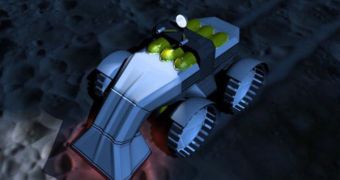Even before lunar probes concluded that water-ice had to exist on the surface of the Moon, engineers at NASA had been studying how to obtain water from the bare space rock. Now that investigations have shown that ice can, indeed, be found on at least several locations, those visions for human exploration have been pushed on fast-forward, and the American space agency is already following up on a few promising leads. These researches could see ice extractors and water generators flying to the Moon when NASA's astronauts return there, in the early 2020s, Space reports.
Radical microwave technologies have proven to be promising in synthesizing water from lunar rocks, even before ice was discovered. This is one of the possibilities that NASA is investigating vigorously at this point, alongside a hydrogen-reduction plant prototype, and a number of lunar-rover prospectors, which have already undergone successful testing in the rocky terrains of Hawaii. In addition to producing drinkable water, these methods would also ensure that the astronauts have a steady fuel and oxygen supply for the duration of their exploration.
The manager of NASA's In-Situ Resource Utilization Project, Gerald Sanders, says that the costs of developing new, complex and efficient technologies are, ironically, much smaller than simply equipping a rocket with additional oxygen, water and fuel tanks, and shooting it at the Moon. According to a report released earlier this year by the California-based Ames Research Center, the technologies and instruments that could be used to extract water from the lunar surface would pay for themselves within less than a year of use.
The new LCROSS mission, inbound for the Cabeus crater on the lunar south pole, will play an instrumental role in determining the way NASA invests its research funds over the next few years. If the impactor showed clear signs of water-ice in the shadowed crater, then the space agency would undoubtedly focus on developing cheap, efficient and light-weight, air-, fuel-, and water-production methods. On a positive note, efforts will not have to start from scratch, as designs that only need a few improvements already exist.

 14 DAY TRIAL //
14 DAY TRIAL //